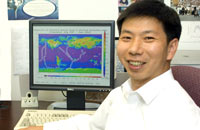Release
UAlbany
Researcher Explores the Formation of
Atmospheric Nanoparticles
NSF
awards Fangqun Yu $500,000 to study
"nucleation," the mechanisms of
atmospheric particle formation
Contact: Catherine Herman (518) 956-8150
 |
|
|
Fangqun Yu |
|
ALBANY, N.Y. (September 20, 2006) -- A team of researchers led by the University at Albany's Fangqun Yu is employing a novel approach to study the formation of nanometer-size particles (or nanoparticles) in the atmosphere. Particles in the air affect the quality of our life in many ways. In polluted urban environments, they lead to adverse health effects and deteriorate visibility. In regional and global scales, atmospheric particles influence the Earth's climate and change hydrological cycle, through scattering and absorbing sunlight and acting as cloud condensation nuclei.
New particle formation (also called nucleation), which has been frequently observed in various locations in the atmosphere, is an important source of atmospheric aerosols. The team's approach integrates a quantum mechanics calculation of cluster thermodynamics with kinetic modeling to address an area of fundamental importance dealing with the formation and growth of nanoparticles in the atmosphere.
A clear understanding of key processes and parameters controlling particle nucleation is critically important for quantitatively assessing the climate-related, health and environmental impacts of atmospheric aerosols and future climate change. Although nucleation phenomena have been intensively studied for decades, mechanisms of particle formation in the atmosphere remain elusive. Yu's research group has received a $496,858 award from the National Science Foundation (NSF) to advance our understanding of atmospheric nucleation. Yu's team includes Alexey Nadykto, a research scientist at the University at Albany and doctoral students Hua Du and Chowdhury G. Moniruzzaman.
"Nucleation theories have not been advanced much fundamentally since the formulation of the classical nucleation theory about half century ago," said Yu, who is on the faculty of the University's Atmospheric Sciences Research Center (ASRC). "It becomes clear that classical approach to nucleation (i.e. approach that base on the approximation that properties such as surface tension of small clusters are identical to that of the bulk condensed phase, well-known as capillarity approximation) is inadequate to give a quantitative description of nucleation for even the simplest scenarios."
The kinetic nucleation approach to nucleation, which Yu's group has been developing, has great advantages over classical nucleation approach because it allows for the incorporation of the thermodynamics of molecular clusters, and provides detailed information about the size distribution of nucleating/growing clusters or particles. Incorporation of cluster thermodynamics, which can be derived from quantum mechanics calculations and analysis of laboratory measurements, can significantly reduce the uncertainties in the predicted nucleation rates. Due to recent advancement in techniques of detecting molecular clusters in the atmosphere, simultaneous measurements of pre-nucleation clusters, mobility spectrums of cluster ions, and the charged fraction of freshly nucleated nanoparticles have become available recently. Proper analysis of these new measurements could shed new light on the mechanisms governing atmospheric particle formation. The kinetic nucleation modeling approach is a nearly perfect choice for accomplishing this task.
"The nucleation mechanisms to be improved or developed under this project will be applied to investigate particle formation in various plumes (for example engine exhaust) and in the atmosphere over United States and Eastern Asia," said Yu. "We hope that our research will lead to valuable insights into a process that is getting better characterized experimentally, but is still not understood from a fundamental perspective."
